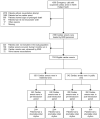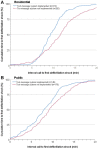Alert system-supported lay defibrillation and basic life-support for cardiac arrest at home
- PMID: 34791171
- PMCID: PMC9009403
- DOI: 10.1093/eurheartj/ehab802
Alert system-supported lay defibrillation and basic life-support for cardiac arrest at home
Abstract
Aims: Automated external defibrillators (AEDs) are placed in public, but the majority of out-of-hospital cardiac arrests (OHCA) occur at home.
Methods and results: In residential areas, 785 AEDs were placed and 5735 volunteer responders were recruited. For suspected OHCA, dispatchers activated nearby volunteer responders with text messages, directing two-thirds to an AED first and one-third directly to the patient. We analysed survival (primary outcome) and neurologically favourable survival to discharge, time to first defibrillation shock, and cardiopulmonary resuscitation (CPR) before Emergency Medical Service (EMS) arrival of patients in residences found with ventricular fibrillation (VF), before and after introduction of this text-message alert system. Survival from OHCAs in residences increased from 26% to 39% {adjusted relative risk (RR) 1.5 [95% confidence interval (CI): 1.03-2.0]}. RR for neurologically favourable survival was 1.4 (95% CI: 0.99-2.0). No CPR before ambulance arrival decreased from 22% to 9% (RR: 0.5, 95% CI: 0.3-0.7). Text-message-responders with AED administered shocks to 16% of all patients in VF in residences, while defibrillation by EMS decreased from 73% to 39% in residences (P < 0.001). Defibrillation by first responders in residences increased from 22 to 40% (P < 0.001). Use of public AEDs in residences remained unchanged (6% and 5%) (P = 0.81). Time from emergency call to defibrillation decreased from median 11.7 to 9.3 min; mean difference -2.6 (95% CI: -3.5 to -1.6).
Conclusion: Introducing volunteer responders directed to AEDs, dispatched by text-message was associated with significantly reduced time to first defibrillation, increased bystander CPR and increased overall survival for OHCA patients in residences found with VF.
Keywords: Automated external defibrillator; Cardiopulmonary resuscitation; Defibrillation; Dispatch; Heart arrest; Ventricular fibrillation; Volunteer responder.
© The Author(s) 2021. Published by Oxford University Press on behalf of the European Society of Cardiology.
Figures




References
-
- Hallstrom AP, Ornato JP, Weisfeldt M et al.; Public Access Defibrillation Trial Investigators. Public-access defibrillation and survival after out-of-hospital cardiac arrest. N Engl J Med 2004;351:637–646. - PubMed
-
- Caffrey SL, Willoughby PJ, Pepe PE, Becker LB. Public use of automated external defibrillators. N Engl J Med 2002;347:1242–1247. - PubMed
-
- Nichol G, Valenzuela T, Roe D, Clark L, Huszti E, Wells GA. Cost effectiveness of defibrillation by targeted responders in public settings. Circulation 2003;108:697–703. - PubMed
-
- Hazinski MF, Markenson D, Neish S et al.; American Heart Association; American Academy of Pediatrics; American College of Emergency Physicians; American National Red Cross; National Association of School Nurses; National Association of State EMS Directors; National Association of EMS Physicians; National Association of Emergency Medical Technicians; Program for School Preparedness and Planning; National Center for Disaster Preparedness; Columbia University Mailman School of Public Health. Response to cardiac arrest and selected life-threatening medical emergencies: the medical emergency response plan for schools: a statement for healthcare providers, policymakers, school administrators, and community leaders. Circulation 2004;109:278–291. - PubMed
MeSH terms
Grants and funding
LinkOut - more resources
Full Text Sources
Medical
Miscellaneous

